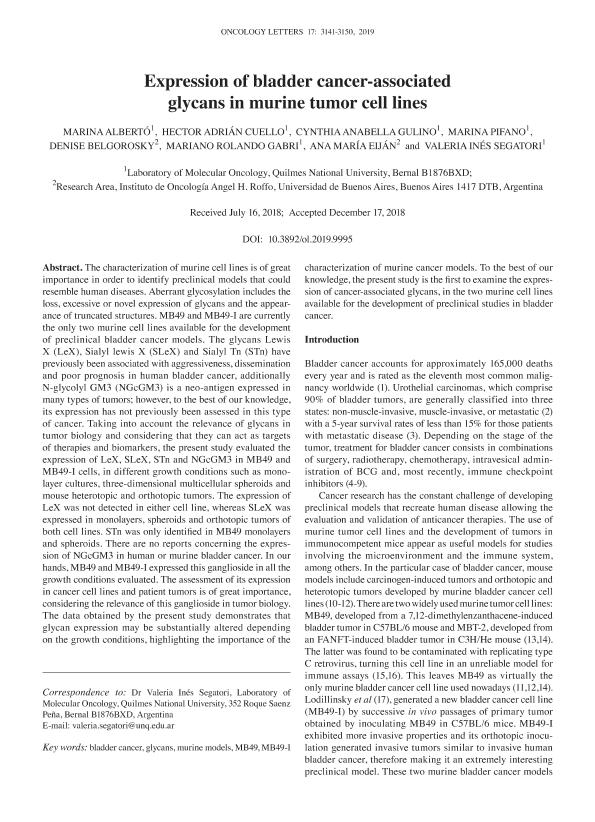Artículo
Expression of bladder cancer‑associated glycans in murine tumor cell lines
Alberto, Marina ; Cuello, Héctor Adrián
; Cuello, Héctor Adrián ; Gulino, Cynthia Antonella; Pifano, Marina
; Gulino, Cynthia Antonella; Pifano, Marina ; Belgorosky, Denise
; Belgorosky, Denise ; Gabri, Mariano; Eijan, Ana Maria
; Gabri, Mariano; Eijan, Ana Maria ; Segatori, Valeria Inés
; Segatori, Valeria Inés
 ; Cuello, Héctor Adrián
; Cuello, Héctor Adrián ; Gulino, Cynthia Antonella; Pifano, Marina
; Gulino, Cynthia Antonella; Pifano, Marina ; Belgorosky, Denise
; Belgorosky, Denise ; Gabri, Mariano; Eijan, Ana Maria
; Gabri, Mariano; Eijan, Ana Maria ; Segatori, Valeria Inés
; Segatori, Valeria Inés
Fecha de publicación:
03/2019
Editorial:
Spandidos Publications
Revista:
Oncology Letters
ISSN:
1792-1082
Idioma:
Inglés
Tipo de recurso:
Artículo publicado
Clasificación temática:
Resumen
The characterization of murine cell lines is of great importance in order to identify preclinical models that could resemble human diseases. Aberrant glycosylation includes the loss, excessive or novel expression of glycans and the appearance of truncated structures. MB49 and MB49-I are currently the only two murine cell lines available for the development of preclinical bladder cancer models. The glycans Lewis X (LeX), Sialyl lewis X (SLeX) and Sialyl Tn (STn) have previously been associated with aggressiveness, dissemination and poor prognosis in human bladder cancer, additionally N-glycolyl GM3 (NGcGM3) is a neo-antigen expressed in many types of tumors; however, to the best of our knowledge, its expression has not previously been assessed in this type of cancer. Taking into account the relevance of glycans in tumor biology and considering that they can act as targets of therapies and biomarkers, the present study evaluated the expression of LeX, SLeX, STn and NGcGM3 in MB49 and MB49-I cells, in different growth conditions such as mono-layer cultures, three-dimensional multicellular spheroids and mouse heterotopic and orthotopic tumors. The expression of LeX was not detected in either cell line, whereas SLeX was expressed in monolayers, spheroids and orthotopic tumors of both cell lines. STn was only identified in MB49 monolayers and spheroids. There are no reports concerning the expression of NGcGM3 in human or murine bladder cancer. In our hands, MB49 and MB49-I expressed this ganglioside in all the growth conditions evaluated. The assessment of its expression in cancer cell lines and patient tumors is of great importance, considering the relevance of this ganglioside in tumor biology. The data obtained by the present study demonstrates that glycan expression may be substantially altered depending on the growth conditions, highlighting the importance of the characterization of murine cancer models. To the best of our knowledge, the present study is the first to examine the expression of cancer-associated glycans, in the two murine cell lines available for the development of preclinical studies in bladder cancer.
Palabras clave:
BLADDER CANCER
,
GLYCANS
,
MB49
,
MB49-I
,
MURINE MODELS
Archivos asociados
Licencia
Identificadores
Colecciones
Articulos(OCA HOUSSAY)
Articulos de OFICINA DE COORDINACION ADMINISTRATIVA HOUSSAY
Articulos de OFICINA DE COORDINACION ADMINISTRATIVA HOUSSAY
Articulos(SEDE CENTRAL)
Articulos de SEDE CENTRAL
Articulos de SEDE CENTRAL
Citación
Alberto, Marina; Cuello, Héctor Adrián; Gulino, Cynthia Antonella; Pifano, Marina; Belgorosky, Denise; et al.; Expression of bladder cancer‑associated glycans in murine tumor cell lines; Spandidos Publications; Oncology Letters; 17; 3; 3-2019; 3141-3150
Compartir
Altmétricas



